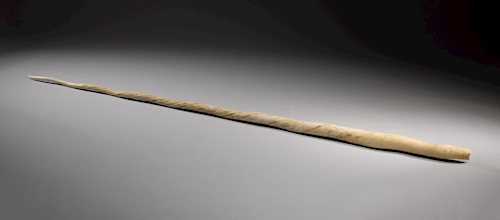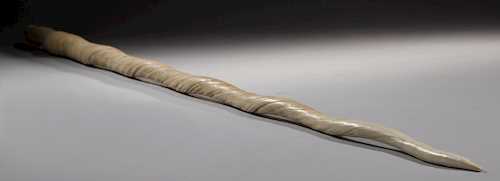
Lot 1824* ♣ - S17 Out of This World - Tuesday, 28. June 2022, 04.00 PM
A TWISTED TALE OF FANTASY AND BIOLOGY
Monodon monoceros
1930 – 1940
192 x 6 x 6 cm
Provenance:
-Collection Max Iten +2015
-Swiss private collection
The narwhal tusk is not just the exemplary and indispensable item that every cabinet of curiosities must contain, but also a prime example for how in these curiosities fantasy and biology, myth and science are found to be entangled.
This contortion already begins with the tusk being actually one extremely enlarged tooth that has more sensory capabilities than any inner teeth would have. So what looks to our eyes like a spear held threateningly in front of the animal is actually a delicate part of the very body it supposedly shields. The tooth that is normally hidden inside the mouth here protrudes for up to 10 feet or 3 meters and accordingly the tusk exposes the animal's sensitive body as much as it protects it.
Long have scientists wondered what this tusk is actually used for because observation of the narwhal in its natural habitat has for long been so difficult. Spending most of their lives underneath the Arctic ice the narwhal's deployment of his tusk has always been obscured from our view.
In the Middle Ages people believed the narwhal horn when grinded to powder would not only be able to cure disease but also work as a potent aphrodisiac. The people of the Middle Ages were of course all the more strongly convinced of the miraculous powers of this organ since they believed the tusk be a unicorn's horn. Narwhal and unicorn – another malformation in which actual animal and mythological entity are twisted into one. The unicorn, this most famous and most fascinating of all the mythical beasts was first described in early Christianity in the Physiologus from Alexandria in the second century AD. From there the unicorn has entered the consciousness of the Middle Ages via several fundamental texts including the famous Thierbuch by Conrad Gessner. As late as the 16th century, he still used the tooth of the narwhal (brought to Europe by sailors) as proof of its existence.
And thus also the tusk of the narwhal has kept its fascinations and secrets: While since Darwin some biologists are convinced that the tusk serves less as an actual weapon than as an asset in sexual selection, similar to the peacock's feathers, other scientists argue the tusk may have other or additional functions. Pointing out the tusk's sensory capabilities it is argued that it could detect changes in the ocean salt concentration, while film footage of hunting narwhals suggest that they also use the tusk for feeding by stunning and hitting cod fish with it.
Used as a stunning tool the narwhal tusk proves to be what we always believed it to be: a magic wand. The tusk is a sensor in murky seas – both in a figurative as well as in a literal sense. The tusk is a medium to establish contact, a phallic fantasy and a metaphysical weapon. The longer we look at it and consider its many histories the more mysterious it becomes. A twisted tale of twisted ideas and fantasies.
The tusk is in a very fine condition, showing a beautiful patina and intact tip.
Literature:
Dawn E. Bastian, Judy K. Mitchell, Handbook of Native American Mythology, Santa Barbara CA 2004.
Danielle Hall, Why a Tusk? The real-life unicorns of the sea and the tusks that make them famous
Jochen Hörisch (ed.), Das Tier, das es nicht gibt: Eine Text- und Bild-Collage, München 2005.
This text by Johannes Binotto
CHF 8 000 / 12 000 | (€ 8 250 / 12 370)
Sold for CHF 16 160 (including buyer’s premium)
All information is subject to change.


